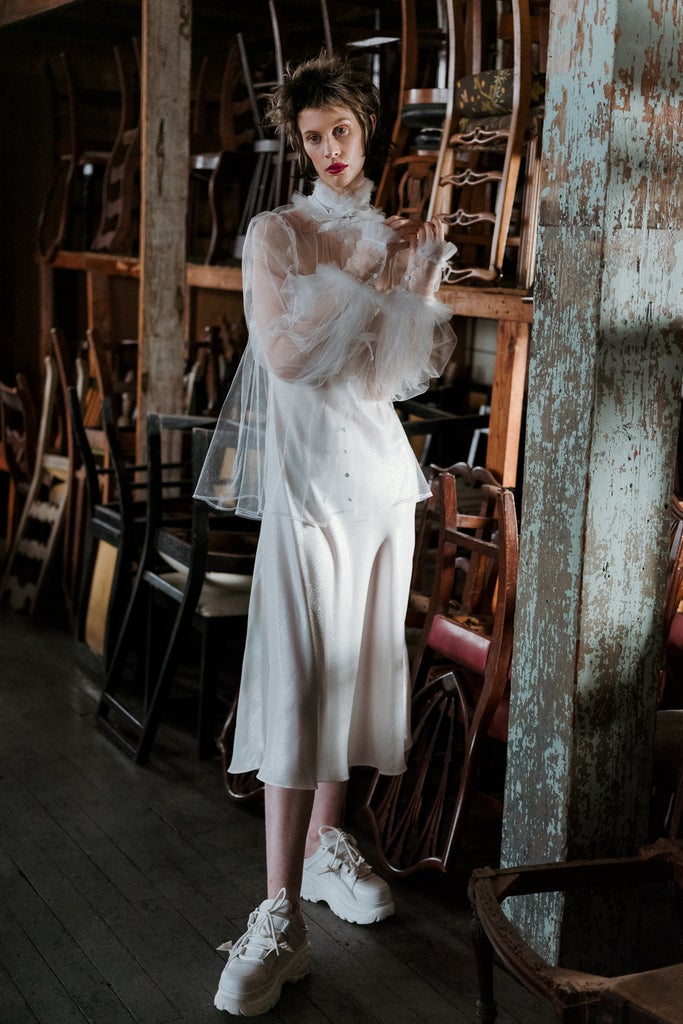
Welcome to Aisle Style, a week-long series that features the most untraditional wedding fashion trends, bridal designers behind the coolest wedding looks, and brides who walk to the beat of their own “Canon In D.” Buck the tradition and say I do to personal style — the aisle is yours.
In an industry as traditional as bridal, it makes waves when a new wedding designer enters the space. This was the case with Thom Browne alum Jackson Wiederhoeft, who burst onto the bridal scene not only with an innovative vision and some of the most unique wedding looks out there but also during a pandemic summer of 2020.
Wiederhoeft quickly generated industry attention and press, with the brand’s genre-bending, joy-inducing confections featuring Romanticism-inspired exaggerated puff sleeves, innovative corsetry, and rows-upon-rows of ribbon bows. And while for his sophomore Spring 2022 bridal collection, the wunderkind pared down (relatively) his avant-garde style — for “commercially-minded styles” for “an old-fashioned girl with an old-fashioned mind,” per show notes — according to him, “the interest so far for clients, and myself, has been primarily on the more experimental styles.”
After two years of pandemic postponements, Zoom nuptials, and micro-ceremonies, weddings are back. According to The Wedding Report, a record 2.5 million nuptials are set to take place in 2022 (up from 1.3 million in 2020 and 1.93 million in 2021). And the related matrimony fashion is looking to be just as celebratory and impactful, following an extended period of more casual and minimal ensembles.
“If you look at the history of fashion, it is always in the moments when the world is feeling like it is unraveling, fashion tends to feel empowered,” says Danielle Frankel designer Danielle Hirsch. Anointed as the young rebel of the industry, the 2019 CFDA/Vogue Fashion Fund runner-up introduced then-shocking bridal crop tops, cut-outs, and pants with her 2017 debut, later followed by even more experimental styles like cone bras. Her most recent collection for Fall 2022 features elaborately-ruched, dramatically-draped, and intricately-pleated sculptural ball gowns, including one in a deep ombré wine hue. The collection encapsulates the collective urge to live life to its fullest and make up for lost time.
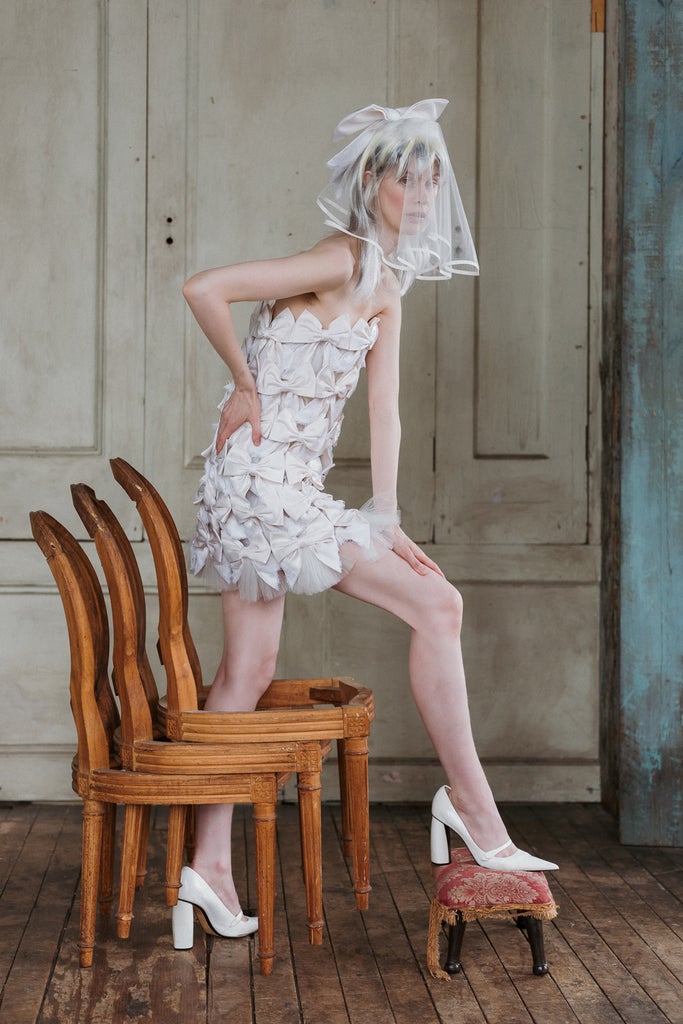
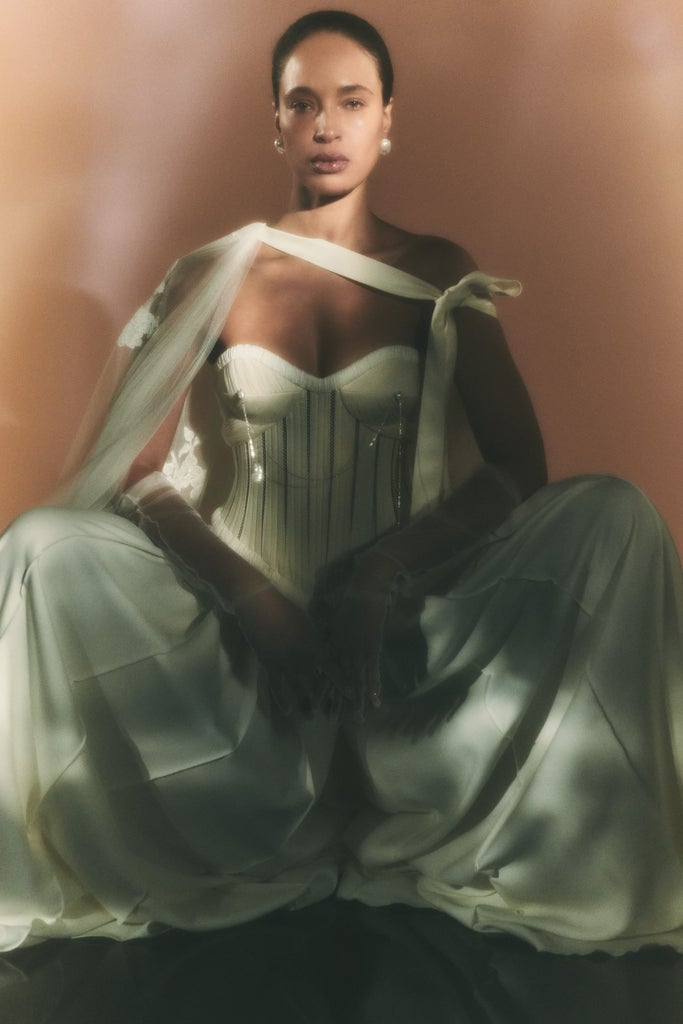
“The attitude these days seems so exuberant, everyone feels very ready to embrace the celebration and really go for it,” says Wiederhoeft. “I think we all realized how fragile life can be, so it’s great to see people embracing their own identities.”
While couples seem less swayed by parents’ approval or general opinions when it comes to wedding dress style — “Brides are wanting to be unapologetically themselves for their weddings, not their parent’s daughter or cupcake version of themselves,” says Frankel — that doesn’t mean couples are bucking tradition altogether. Instead, couples now often pay homage to their roots. “Brides are incorporating their culture, whether it’s religion, or otherwise,” says Scorcesa founder Charles Dieujuste. “They want a piece of that during their wedding day.” Indeed it’s true: According to The Knot 2021 Real Weddings Study, 6 in 10 couples say that it’s important to incorporate their ethnicity, religion, and/or culture throughout their wedding; 75% of BIPOC couples say the same.
In 2020, the publicist-turned-bridal designer founded Scorcesa in celebration of his multicultural Haitian American heritage. In turn, Dieujuste often speaks to clients looking to honor their culture on their biggest day. He recalls a bride wishing to represent the vibrant colors of East Indian weddings through a chic red-and-gold leaf ensemble. “[Clients] love to incorporate tradition, but don’t want it to be like, the ‘traditional wedding’ [look,]” says Dieujuste.
In addition to fulfilling these custom orders, Dieujuste offers more “daring silhouettes,” designed specifically to suit the lifestyle of the “modern” and “non-traditional” bride. Scorcesa’s signatures include chic mix-and-match pieces: fluttery crop tops, sleek bandeaus, tailored trousers, polished detachable accents, and flounce-hem ball gown skirts. For the new season, he is showcasing sparkling sequins, dramatic sleeves, sultry cut-outs and open-back, higher slits, and deeper plunging necklines. “Brides are looking for more of a moment,” he says.
For his upcoming May release, Wiederhoeft is also leaning into “the spectacle” desired by his risk-taking and adventurous clientele — and his theatrical, high-spirited design inclinations. “We are exploring everything, from giant ball gowns covered in corset-lacing to embroidered mini-dresses and severe corseted suiting,” he says. “I think this is what people come to the brand for — it’s what we do best: creating a narrative, an experience.”
Look to the data, too: According to online marketplace Love The Sales, global search for “non-traditional wedding dresses” has surged 60%, compared to the last 12 months, while demand for specific fashion-related details has spiked over the same period: “fringe wedding dresses” 53%, ‘90s-influenced “square neck wedding dresses” 60%, “wedding separates” and “colored wedding dresses” 50%, and “wedding jumpsuits,” a whopping 173%.
“The non-traditional bride is the sweet spot for us,” says Alexandra O’Neill. After founding her celebrity-beloved label Markarian in 2017, she introduced a bridal category for Fall 2019, following a demand from her clients for wedding iterations of her signature modern, playful twists on classic romantic silhouettes and details like 3-D textures and appliqués. “People are looking for something that’s a little bit more special and, I would say, ‘more fashion-forward.’”
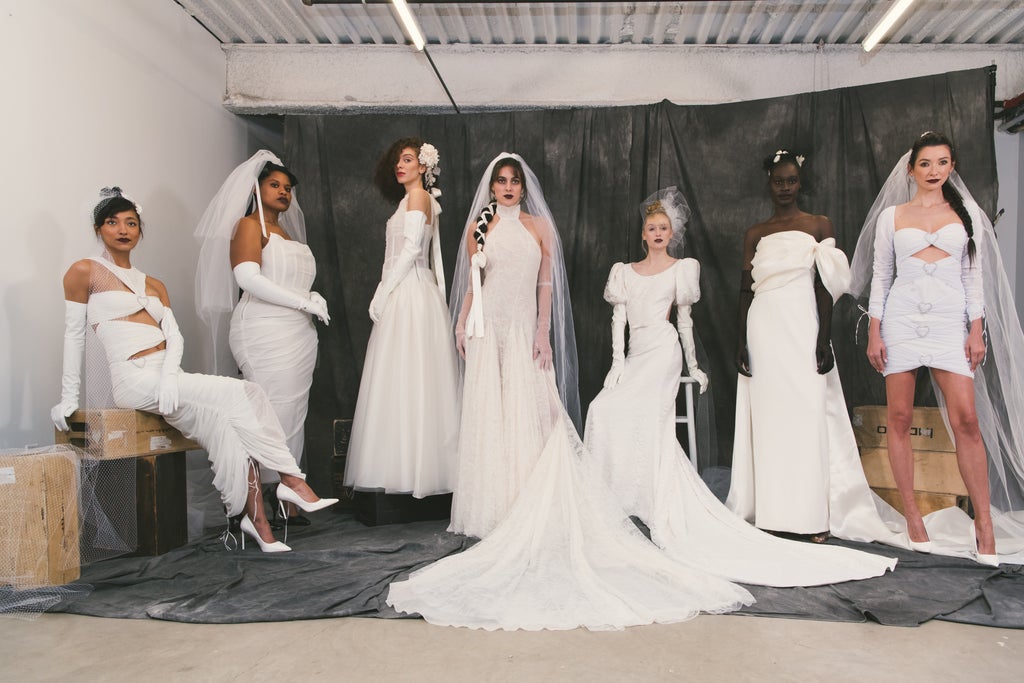
Still, even with a demand for more unique wedding styles, designers walk a delicate balance of event-appropriate and self-expressive. Just ask Katharine Polk, who founded Houghton in 2011 as an innovative brand to “blur” the line between ready-to-wear and bridal. Considered the OG bridal disruptor, Houghton pushed against the boundaries of the rigid, traditional landscape with ultra-wearable, cool-kid elements like leather moto-jackets, customized denim, plus cut-outs and pants.
“[Houghton is] rooted in reality and what real women want [and can] wear with a drop of romanticism and fantasy. We don’t base our collections on trends, but we seem to keep in line with what we’re seeing on the ready-to-wear runway — and that means sometimes it’s too soon for the bridal world,” says Polk, who paused Houghton in January 2018, launched a self-named direct-to-consumer line in January 2021, and then revived the original brand in October that year. (Houghton is now exploring a new retail concept in partnership with online platform Dress Hunt.) Houghton 2.0’s sophomore capsule for Spring 2023 features an ‘80s-referential ruched and cut-out lilac mini-dress and a lace overlay, puff shoulders, and crystal-detailed gown with dramatic opera gloves.
To marry (sorry) fashion and function, Wiederhoeft is bridging an experimental, unexpected element with classical wedding themes, like bows, taffeta, and tulle. “One of my favorite pieces is from the first bridal collection: a strapless mini dress that feels very cocktail or evening, but the fabrication is double-faced satin bows edged in white lace,” says Wiederhoeft, comparing the effect to “a perfect little wedding cake.”
Frankel also emphasizes blending classic, recognizable elements with cutting-edge takes, like futuristic pleating techniques on fluttery silk organza or intricate 3-D floral appliqués on a bandeau top. “Many of the old formalities are no longer expected. We are reflecting on the classical elements of bridal, but making them more modern — and that’s why it works,” says Frankel. “When you completely throw out the tradition entirely, it can come across as kitschy.”
The idea of “non-traditional” bridal expands beyond wedding wear, as consumers push back against outdated norms and constrictions surrounding the day. It’s worth noting that all five designers have size-inclusive brands to bring joy to many people long ignored by the industry during one of their most important — and emotional — purchases. The bridal industry, through its marketing and messaging (and in the term itself) also pushes a heteronormative, cis-gender standard. “As a non-binary person, I don’t feel that ‘bride’ or ‘groom’ really fits me, which is part of why I say ‘celebrant’ instead of ‘bride,”’ says Wiederhoeft, who does find boundless inspiration in “princesses, faeries, and corsets.” “But, it’s a start point and a muse, not an end goal. I think this pathway of very ‘feminine’ ideas can go in so many directions, and it starts to twist that tale-as-old-as-time narrative.”
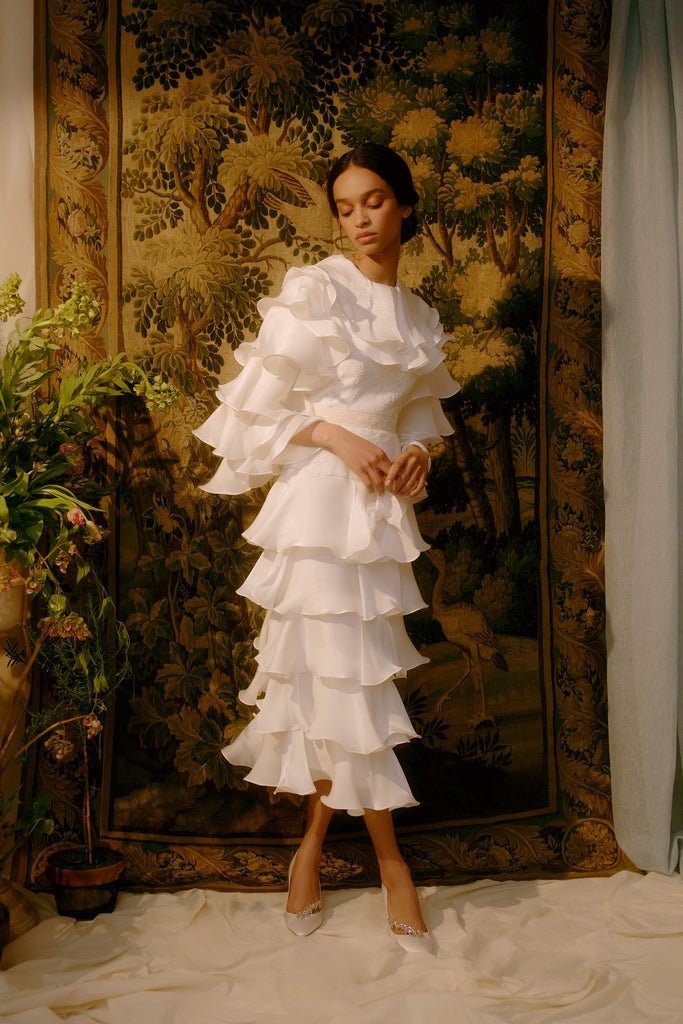
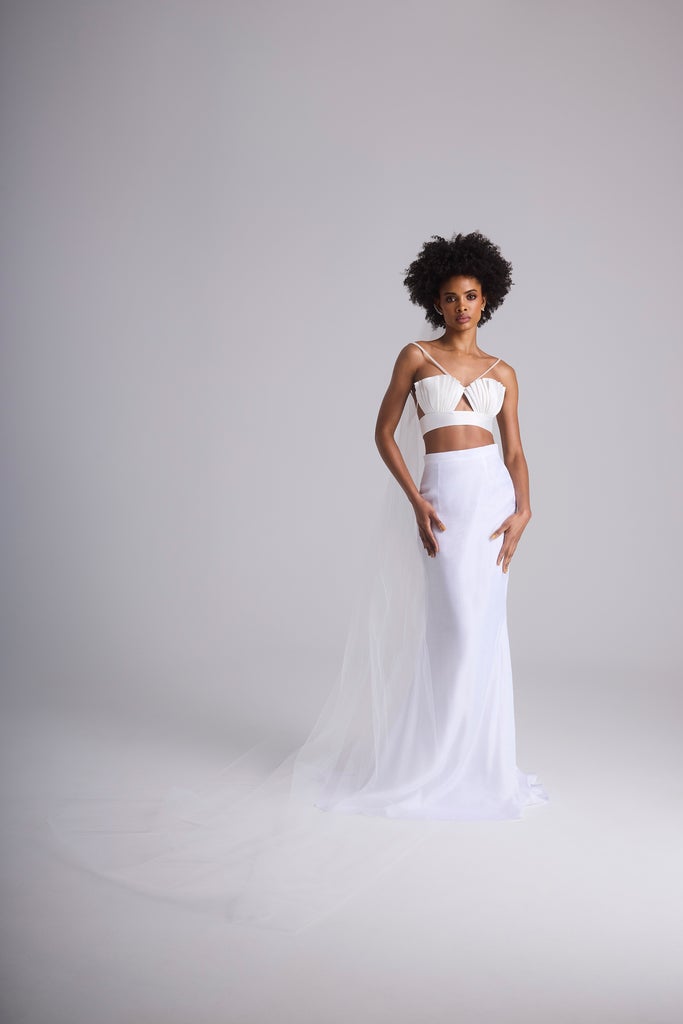
The past two years have also involved self-introspection and reassessment of values and intentions, especially regarding consumerism and consumption. The WeddingWire 2022 Wedding Trends Report found that couples are emphasizing sustainability in the planning process of pending nuptials, fueled by millennials and Gen Z tying the knot. “I believe that the ‘modern bridal market’ has now been recognized as a sustainable category in the bridal industry rather than a niche,” says Polk. She founded Houghton to locally and ethically manufacture in Los Angeles and practice sustainability in design and production. The brand ethos also encourages (and attracts) clients interested in recycling and re-wearing her pieces.
Dieujuste also designs and produces Scorcesa locally in New York City with the intention for clients to re-wear their pieces. “The DNA of the brand is pretty much investment looks for the ‘modern bride,’” he says. “It’s like, ‘Hey, I’m on the go. I’m doing a million things. The one thing that I don’t want to worry about is a gown in my closet that I’m not going to wear ever again, after one day.” According to him, a London destination wedding bride, who just bought an A-line crop top and wide-leg trouser set, already looks forward to wearing the look as separates following her big day, while another is contemplating a tuxedo.
While conscious brides seek out Markarian for its waste-reducing made-to-order model and usage of sustainable fibers, they also value the smart, practical purchase. “They’re looking for something that isn’t just a one-off piece, but is something that they can work into their wardrobe,” says O’Neill.
Today’s non-traditional wedding consumer isn’t just searching for a unique, self-expressive look to represent a landmark life moment, but also making an intentional investment purchase, which could become a reusable keepsake for the future — transcending fashion trends. (See: Rachel Sennott who wore Wiederhoeft’s bow-covered wedding mini-dress on the red carpet for the New York premiere of her film, Shiva Baby.)
“Instead of trying to embody every emotion of the celebration in one look, they can divvy it up and express themselves in a few chapters,” says Wiederhoeft. “It’s really exciting and liberating.”
Like what you see? How about some more R29 goodness, right here?
Why More Brides Are Choosing Black Wedding Dresses
The Biggest Bridal Trends For Spring 2023
26 Non-Traditional Engagement Rings
from Refinery29 https://ift.tt/l05YgQp
via IFTTT
